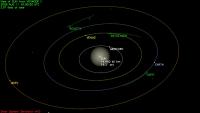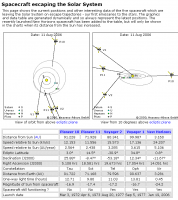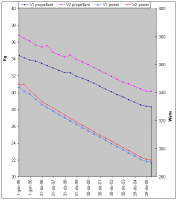Printable Version of Topic
Click here to view this topic in its original format
Unmanned Spaceflight.com _ Voyager and Pioneer _ Voyager-1 at 100 AU!
Posted by: dilo Aug 2 2006, 12:51 PM
Nobody highlighted this and I didn't find any comment from Nasa/Voyager sites.
On August,11 the intrepid Voyager-1 probe will reach 14.960 billion Km from the Sun, one hundred times the average Earth-Sun distance!
This event will be followed, after 16 days, by the 100AU from Earth reach.
From astrophysical standpoint, first event is the most important but, I think, most people will be emotionally hit from the second one.
So I would like to start a poll on this.
Posted by: David Aug 2 2006, 01:29 PM
From astrophysical standpoint, first event is the most important but, I think, most people will be emotionally hit from the second one.
Obviously, we need to celebrate continuously from August 11 to August 27.
Posted by: RNeuhaus Aug 2 2006, 02:32 PM
I would rather prefer AU as the reference from Sun. The Earth is no longer as the center of the world which were tought in the older times....
Rodolfo
Posted by: dilo Aug 2 2006, 02:34 PM
Not a bad idea!
I must apologize on a little error in my first post. The 100AU from Earth event will occour on Aug,26 - not 27.
I'm using NASA space simulator (what about other sources?)
Posted by: MizarKey Aug 2 2006, 03:35 PM
Rodolfo
While that may be true, it is still the 'point of origin' for the craft...didn't leave the sun to go on a journey...
Posted by: climber Aug 2 2006, 07:20 PM
Dilo,
I understand you use Nasa space calculator but, does the difference goes as 100-1 for Earth distance or do you consider the EXACT position of Earth on August 25th? You know, the difference could be + or - 1 UA depending where's the Earth on its orbit. By the way, August 25th is prety close to celebrate the 17th anniversary of Voyager II fly-by of Neptune.
By the way, if you open up a pool like arrival of Oppy at VC or Eagle, my bets are 100 UA from SUN first ![]()
![]()
![]()
Can you tell us when the round trip signal will need 24 hours?
Posted by: dilo Aug 2 2006, 10:01 PM
Climber, using Nasa space SIMulator is pretty easy to know the exact moment of both events, withut additional calculation... moreover, as you can see from following snapshot, Earth will be going farther from Voyager at this epoch, so no risk of "multiple" 100AU events!
We passed the time for 24hrs signal round trip (go and forth) in Nov 2002; if you are asking about the time when round trip signal will need 24 hours to reach Voyager (173 AU), this should happens at the beginning of 2027 but, unfortunately, at this epoch Voyager will be dead.
Posted by: climber Aug 3 2006, 11:02 AM
Dilo, by then Voyager will already be 50. I thougth they'll expect them to last up to 2025 or may be it was 2015.
Posted by: ups Aug 3 2006, 11:58 AM
Dilo, by then Voyager will already be 50. I thougth they'll expect them to last up to 2025 or may be it was 2015.
I believe it's 2025-30 but there is no telling -- they may continue to work many years past that point.
Posted by: climber Aug 3 2006, 01:19 PM
![]()
![]()
![]()
![]()
Posted by: dilo Aug 3 2006, 02:28 PM
http://voyager.jpl.nasa.gov/science/index.html
In about 10 years from now they will start to share power between instruments (now we are around 290W output, like Spirit at Gusev!). Let's hope ups is right (name seems appropriate!) ![]()
Posted by: Jeff7 Aug 3 2006, 06:46 PM
Celebrate when it gets 100AU from the point where Earth was when Voyager was launched.
Posted by: mars loon Aug 3 2006, 06:48 PM
without a doubt, celebrate 100 AU from the sun
Posted by: paxdan Aug 3 2006, 09:50 PM
Thirded, there comes a point where the meaningful measurement uses the system star as the reference point. If any thing deserves this, it is most certainly Voyager: our most distant physical ambassador.
Posted by: ljk4-1 Aug 4 2006, 04:28 PM
When the Pioneers and Voyagers are 100 light years from Sol, then we'll talk celebration.
![]()
If they can just track the Voyagers' radio signal after the probes are no longer
able to power any of their science instruments, how many more years will that
last and what science could we gain from it?
Posted by: ilbasso Aug 4 2006, 04:48 PM
We're well past that if you take into account the Earth's and the Sun's motion due to galactic rotation...
...and motion of the Milky Way relative to the rest of the Universe...
Posted by: Planet X Aug 4 2006, 05:00 PM
Well, it should be known that August 26th marks the 25th anniversary of Voyager 2's Saturn encounter. What a perfect day for Voyager 1 to reach 100 AU from earth! I'm already celebrating Voyager stuff that day, so why not have one thing more to celebrate. Later!
J P
Posted by: dilo Aug 4 2006, 05:01 PM
...and motion of the Milky Way relative to the rest of the Universe...
Not speaking of universe expantion, Mr strangelove!
Posted by: ljk4-1 Aug 4 2006, 07:08 PM
Rodolfo
That is a relatively modern perception of how the ancients viewed the world.
If you read Dennis R. Danielson's The Book of the Cosmos: Imagining the Universe
from Heraclitus to Hawking, you will find that the ancients viewed Earth as being not
at the center of all things in terms of either physical parameters or importance, but
at the bottom of a vast pit both in the literal and moral sense. Only as one rose
above the "sphere" of the Moon did one find a more pure and perfect existence,
as the stars and planets were thought to exist in.
It took Copernicus and especially Galileo to rise us up from the mire and make us
one among the stars. This idea that Earth was "just" a planet circling a star was
thrilling to Galileo in that sense, and deeply concerned the powers that be (read
The Catholic Church), for if mere mortal, sinful humans were not wallowing down
in the cosmic cess pool of existence in constant need of saving, then their self-
made authority on Earth was threatened - that's what was really going on between
Galileo and the Church.
As for Voyager and the 100 AU mark, the amazing thing is that sooner than later, for
all of our interstellar probes, the distance differences between Sol and Earth will be
virtually irrelevant.
Posted by: Analyst Aug 5 2006, 06:40 PM
The two Voyager spacecraft have always been special for me. From a scientific, a programmatic and an engineering point of view they stand out.
They explored four planets in detail for the first time (I am a little unfair to Pioneer 10 and 11), and countless moons. They discovered new moons, volcanos on Io and geysers on Triton. The Voyagers carry an almost complete suite of then state of the art instruments found rarely before and after. Today budget pressure leaves you often with only a very limited number of instruments. Look at DAWN, we built the first asteroid orbiter and cut the magnetometer and laser altermeter. Or MER without a weather station.
It has not been easy for the Voyager program in the 1970ies. There were first four much larger probes. Later it was hoped to sent one to Pluto. Not to happen, only two smaller ones, less expensive. Then politics wanted to shut them down after the Saturn encounter. Now this program has been running for 35+ years. A lot of their fathers retired or passed away, they are still working at the final frontier.
Their engineering design included some very clever things, some used for the first time. I am still impressed by the telecom system: X-band primary with 115.2 kbps from Jupiter, 21.6 kbps from Neptune. New Horizons will have 768 bps planned from Pluto, hopefully a little more (maybe twice). Onboard image compression. Important for rapid instrument pointing is the scan platform. Or look at the scheduling difficulties Cassini has between data collection and downlink becuase there is no such platform. Also for the first time: an integrated SRM and hydrazine trusters. And gyros and star trackers still working after 29 years. So they still point to earth and hopefully will for a long time to report entering true interstellar space.
I wish them a long live, always a good link margin. And may the budget last longer than the RTGs.
Analyst
Posted by: dilo Aug 5 2006, 08:28 PM
Well said, analist!
Voyager mission is a miracle, from both science and tech standpoint. I deeply admire who conceived, build and managed these probes.
Can you tell more about initial plan to send 4 larger spacecrafts???
Posted by: JRehling Aug 6 2006, 05:47 AM
I don't know -- speed of light travel time is still based on Earth, until DSN expands to the Sun.
I bet a lot more people have looked into the sky, picked out a small light and wondered "How far away is that?" than have wondered "How far is that from the Sun?"
Earth-Firsters!
Posted by: Analyst Aug 6 2006, 08:37 AM
Voyager, the grand tour, started as the Thermoelectric Outer Planet Spacecraft (TOPS) in the late 1960ies Because of the long travel time a new computer, the so called Self Test And Repair (STAR) general purpose machine was planned to be used. Different launch strategies were discussed. One was two launches in 1977 to Jupiter-Saturn-Pluto and two in 1979 to Jupiter-Uranus-Neptune. The ideal planetary alingment in the late 1970ies has been identified at Caltech/JPL. The spacecraft were not that much larger (although they required a Titan 3E with 7 segment SRMs for some trajectories), but more sophisticated, designed to suvive 10+ years, and thus more expensive. In the early 1970ies, during the end of Apollo and the birth of the Space Shuttle, the Nixon administration canceled TOPS, the grand tour, for budget reasons (They had a useless war to fight, very much like today.).
Shortly thereafter NASA came up with Mariner Jupiter-Saturn (MJS), a design based on the Mariner spacecraft, being less expensive and more simple. MJS used a lot of the Viking computer and you can see the Mariner heritage if you look at the 10-sided bus. During development MJS involved into an almost new design: 3.7m high gain antenna, X-band primary, radiation hardened parts, RTGs, hydrazine trusters etc. But MJS was planned only explore Jupiter and Saturn within a four year mission. Before launch it was renamed Voyager (The program to develop unmanned Mars landers to be launched on Saturn launch vehicles has also been called Voyager in the 1960ies and later became Viking.). During launch were was the option to send the first launched spacecraft (JSX) to Uranus (X=U), if the other (JST) performed well during its mission including the very important close Titan encounter. We all know it did and Voyager 2 went to Uranus and Neptune. And both are still working.
It is a great story, even long before launch. A good reference is: http://www.amazon.com/gp/product/1588341240/sr=8-1/qid=1154853280/ref=sr_1_1/104-6974456-7058345?ie=UTF8
Analyst
Posted by: edstrick Aug 6 2006, 08:43 AM
The AIAA journal "Astronautics and Aeronautics" had a major article on TOPS in an issue in the early 70's, before the mission was canceled and re-created as Mariner Jupiter/Saturn, then Voyager. I was P****D when they renamed the vehicles from Mariner 11 and 12 to Voyager 1 and 2. I'm sure it was a NASA HQ public information office stupidity, figuring a #1 would be more interesting than a #11.
Posted by: dilo Aug 6 2006, 10:11 PM
Thank you for the infos, Analyst!
Posted by: ljk4-1 Aug 7 2006, 01:53 PM
But then we wouldn't have had Star Trek: Voyager, and what would V'Ger have done?!
M'rner?
Posted by: paxdan Aug 7 2006, 01:57 PM
M'rner?
p'neer
*snigger*
Posted by: mchan Aug 8 2006, 01:09 AM
No, the Klingons blew P'neer to bits in one of the movies.
Posted by: ljk4-1 Aug 8 2006, 01:27 AM
Star Trek 5: The Final Frontier, made in 1989. The worst of the lot, made
worse by having the Klingons use humanity's first ambassador into the galaxy
as target practice.
They did recreate Pioneer 10 accurately, except that the famous Plaque was
bolted on facing in towards the probe to protect its engravings from the
ravages of deep space. But obviously it was not enough to protect it
from Klingon phasers.
I also don't think Pioneer 10 would look quite as worn as the film version
did in just 300 or so years, but I haven't had the chance to check the probe
in person.
http://www.memory-alpha.org/en/wiki/Pioneer_10
I suppose this also means that since Pioneer 10 couldn't have gotten too far
from Earth on a relative scale in just three centuries, the Klingon warship was
pretty darn close to the Sol system. Voyager 6 (V'Ger - not M'Rner) at least
had the excuse of falling into a black hole to get so far away so fast.
Posted by: Holder of the Two Leashes Aug 10 2006, 04:06 AM
Can't help but doubt it. 100 AU from the "creator", say I. V'ger could care less about transmitting to the sun. It's locked on to receivers that will be 100 AU away later this month.
Posted by: dilo Aug 11 2006, 06:29 AM
While Space simulator tell us today as the 100AU-from-Sun day, Heavens-above site suggest we have to wait tomorrow... (Voyager1 covers 0.010 AU/day):
The official sites still not mention the milestone, let's see in the next hours!
In the meantime, we can start the two weeks long celebrations...
Posted by: Phil Stooke Aug 11 2006, 01:46 PM
Party Poopers! Celebrate both occasions...
Phil
Posted by: SigurRosFan Aug 11 2006, 08:53 PM
Here's my 100 AU prediction: August 12, 2006, 11:30 UT
Posted by: SigurRosFan Aug 12 2006, 11:27 AM
11:25 UT ...
- http://www.heavens-above.com/solar-escape.asp?lat=50.933&lng=6.950&alt=46&loc=Cologne&TZ=CE
Posted by: Planet X Aug 12 2006, 07:05 PM
Why is there such a lack of coverage on this important milestone? I mean, I've seen nothing about it on the news, other sites, or even the Voyager homepage!
BTW, Voyager 2 will reach 100 AU in mid-November 2012, while slowpoke Pioneer 11 will take until late-January 2019 to reach 100 AU! Later!
J P
Posted by: djellison Aug 15 2006, 12:58 PM
Planetary Radio covered it this week with Ed Stone as the guest ![]()
Doug
Posted by: dilo Aug 15 2006, 03:21 PM
Thanks for the highlight, Doug!
Ed had the incredible privilege to follow Voyager mission from development stage to Interstella Mission (34 years, till now! ![]() ).
).
Meanwhile, I made these plots based on weekly reports published in the Voyager sites (source: http://voyager.jpl.nasa.gov/mission/weekly-reports/index.htm).
While first one show historic distance and velocity from Sun, second one is the most interesting because reports the propellent and power availability in last 11 years.
If we exclude very last points (which are probably wrong), linear interpolation show that hydrazine, with current consumption rate, should last 45 years on V1 and 50 years on V2.
On the energy side, Voyager-2 has a constant, 6 months advantage over his brother. The negative-exponential power interpolation of last 5 years trend suggest an average half-life time of 47 years (it was slightly shorter in previous years) - I guess this is the product of plutonium decay and termocouple/electronics slow degrade...
Finally, the margin figures are a little bit misterious to me, because the difference between actual power output and this margin isn't constant... anyway, shouldn't be so important for spacecraft life because, fortunately, they can switch off instruments in order to increase that margin.
Posted by: ljk4-1 Aug 15 2006, 03:32 PM
Very nice charts, Dilo, thanks.
Considering that Voyager 1 visited fewer worlds than Voyager 2 and it
would therefore be assumed that it used less propellant, why does it have
less hydrazine in fact?
Posted by: remcook Aug 15 2006, 03:42 PM
Good to know I'm not the only one nerdy enough to do this
Posted by: djellison Aug 15 2006, 03:44 PM
It's only a couple of Kg - it may well be that the trajectory for the initial launches were such that additional payload capacity was available for V2 and thus it was tanked up a little heavier. (Identical LV's on slightly different traj's would suggest slightly different mass budgets perhaps)
Perhaps because V1 was the first one out the gate, the lessons learnt on how to minimise fuel useage were learnt on V1 and carried over to V2.
And it's not hard to imagine one extreme safing event causing a big chunk of fuel useage at some point during a 20+ year mission.
Lots of reasons that could cause the difference.
Doug
Posted by: Analyst Aug 15 2006, 04:49 PM
The Voyager 2 launch window has been more demanding for the Titan 3E. Voyager 1 has been the less demanding and only because of this very reason the Centaur upper stage of this launch vehicle was able to compensate for a Titan second stage propellant leak and the resulting underspeed. Voyager 1 needed a pretty high delta v to target for the Saturn and Titan encounters (and occultations) after the Jupiter flyby.
I have been locking for more engineering details abaout Voyager, including TCMs. Never found much.
Analyst
Posted by: ljk4-1 Aug 15 2006, 08:32 PM
The Guardian had an editorial on the Voyager 1 100 AU anniversary in
its August 8 edition here:
http://www.guardian.co.uk/leaders/story/0,,1839454,00.html
Posted by: dilo Aug 16 2006, 09:14 PM
Finally, JPL news http://www.jpl.nasa.gov/news/features.cfm?feature=1150 it!
The date is 3/4 days after what we said based on SpaceSimulator and HeavensAbove... ![]()
(thanks to http://spacespin.org/ for the highlight).
Posted by: dilo Aug 17 2006, 05:35 PM
...and http://www.nasa.gov/mission_pages/voyager/voyagerf-20060815.html too!
Posted by: RNeuhaus Aug 19 2006, 01:10 AM
New Horizonts salutes Voyager.
Though New Horizons will also reach 100 AU, it will never pass Voyager 1, because Voyager was boosted by multiple gravity assists that make its speed faster than New Horizons will travel. Voyager 1 is escaping the solar system at 17 kilometers per second. When New Horizons reaches that same distance 32 years from now, propelled by a single planetary swingby, it will be moving about 13 kilometers per second.
New Horizons will reach 100 AU in December 2038.
Rodolfo
Posted by: dilo Aug 19 2006, 05:14 AM
Thanks, Rodolfo.
Let's hope NH will be operative 32 years for now, in order to check variations in the termination shock...
Posted by: mimile Dec 25 2006, 10:17 AM
That is a very late answer for V1 (and quite early for V2) : I'll propose neither 100 AU from the Sun, nor 100 AU from the Earth, but 100 AU from the Solar System center of gravity. After all, the Voyager's trajectories are simpler when expressed from the center of gravity, now that they are so far away from the major planets.
In practice, this will seldom change the date by more than a fraction of one day (the maximum effect from Jupiter is about half a day).
Posted by: centsworth_II Dec 25 2006, 07:25 PM
How far from the sun can this get?
In the study of the heliosphere and heliopause, it makes sense to reference the distance of the craft from the sun. Maybe in studies of the "Pioneer anomaly" the craft distance from the solar system center of gravity would be the best reference. If the only science coming from Voyager involves the heliosphere, the best reference would be from the sun. IMHO
Powered by Invision Power Board (http://www.invisionboard.com)
© Invision Power Services (http://www.invisionpower.com)




